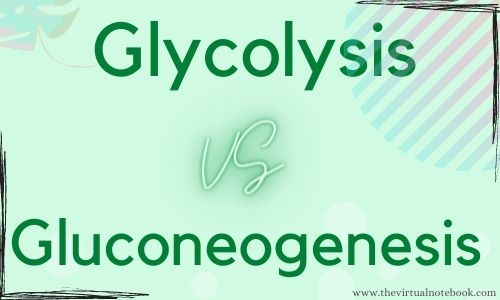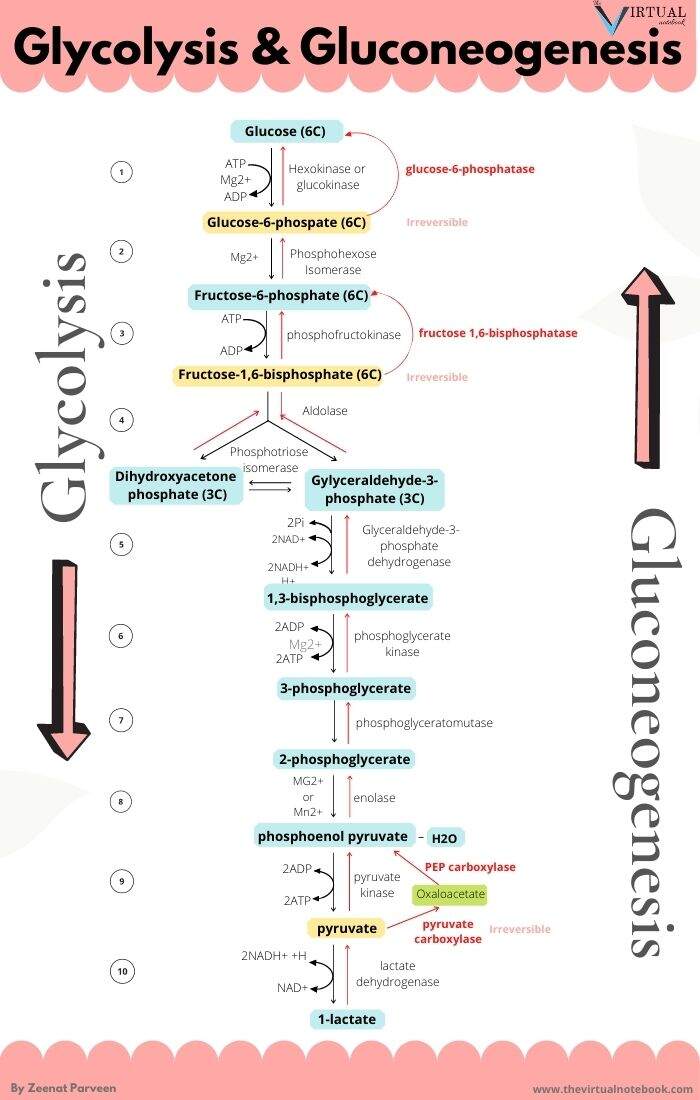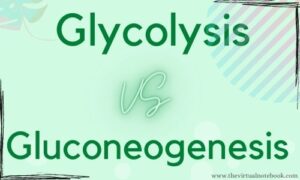In this article “glycolysis vs gluconeogenesis”, we will discuss the similarities and differences between the two major pathways of glucose metabolism. I tried to collect all the possible contrasting and similar points regarding this topic and represent them tabular at the end of the article.
I hope you find this article helpful…
Glycolysis
Glycolysis is the major pathway for glucose metabolism in which glucose will convert to pyruvate (under aerobic condition) or lactate (anaerobic). Afterwards, Pyruvate can be completely oxidized to CO2 and H2O by enzymes present in the mitochondria. Basically, glycolysis occurs in the cytosol of all the cells and is also known as “Embden-Meyerhof-Parnas pathway”.
For more information, see: Glycolysis pathway
Gluconeogenesis
Gluconeogenesis is the process of synthesizing glucose or glycogen from non-carbohydrate precursors. Gluconeogenic precursors are molecules that can be used to produce a net synthesis of glucose. Indeed, the most important gluconeogenic precursors are glycerol, lactate, and the α-keto acids obtained from the metabolism of glucogenic amino acids. The liver and kidney are the major gluconeogenic tissues, but the small intestine may also be a source of glucose in the fasting state.
Gluconeogenesis occurs mainly in the cytosol, although some precursors are produced in the mitochondria. In addition, it involves several enzymes of glycolysis, but it is not a reversal of glycolysis. The irreversible steps in glycolysis are bypassed by four enzymes which are the key enzymes of gluconeogenesis.
For more information, see: Gluconeogenesis pathway
Glycolysis VS Gluconeogenesis

Similarities between glycolysis and gluconeogenesis
- Both are metabolic pathways occur in glucose metabolism of the cells.
- In both pathways, glucose is a common molecule. Although, glucose is the reactant, or starting point in glycolysis while it is the product or endpoint in the latter.
- Glycolysis and gluconeogenesis both occur in the cytoplasm of cells. In addition, both share a common site of pathway i.e., liver.
- Both make use of ATP and water.
- Both processes can function under aerobic condition. Although, glycolysis is also active in anaerobic condition.
- Overall, glycolysis has ten reactions step whereas 11 steps are there in gluconeogenesis. In addition, seven reactions are common for both glycolysis and gluconeogenesis.
- The two pathways also have a number of other molecules in common. For example, pyruvate is the main “entry point” of gluconeogenesis, whereas, in glycolysis, it is the primary product.
Difference between glycolysis and gluconeogenesis
Glycolysis and gluconeogenesis are two pathways of glucose metabolism. One is the breakdown of glucose while other is the synthesis of glucose. Gluconeogenesis closely resembles the reversed pathway of glycolysis, although it is not the complete reversal of glycolysis. In glycolysis, one glucose molecule will break into two pyruvate molecules. On the other hand, two pyruvate molecules come together to form a glucose molecule in gluconeogenesis. Below, I am sharing glycolysis vs gluconeogenesis differences in a tabular form. But before that, let’s discuss those points in brief.
1. Defintion
The very first point we are going to discuss in glycolysis vs gluconeogenesis is based on their definition.
Glycolysis definition: The word ‘Glycolysis’, derived from the Greek words, ‘glykys‘ which means sweet; and ‘lysis‘ which means splitting. Hence, glycolysis technically means ‘splitting of sugar’ or ‘breakdown of sugar’.
Basically, glycolysis is the major pathway for glucose metabolism in which glucose will convert to pyruvate (under aerobic conditions) or lactate (anaerobic). Afterwards, Pyruvate can be completely oxidized to CO2 and H2O by enzymes present in the mitochondria. Further, the process comprises ten reactions that occur in the cytoplasm of the cell.
Gluconeogenesis definition: Gluconeogenesis is the synthesis of glucose from compounds that are not carbohydrates. The major substrates are glucogenic amino acids, lactate, glycerol, and propionate. Essentially, the liver and kidney are the major gluconeogenic tissues, but the small intestine may also be a source of glucose in the fasting state.
Gluconeogenesis meets the needs of the body for glucose when insufficient carbohydrate is available from the diet or glycogen reserves.
2. Mode/condition
The second difference is based on the availability of oxygen conditions. This difference will tell which pathway can occur with or without the availability of oxygen.
Glycolysis can occur as both aerobic and anaerobic depending on the availability of oxygen and the electron transport chain. On the other hand, gluconeogenesis is an anaerobic process. Pyruvate is the end product of aerobic glycolysis whereas lactate will produce under anaerobic glycolysis.
3. Location/site
Glycolysis takes place in all the cells of the body while gluconeogenesis occurs mainly in the liver, and to a lesser extent in the renal cortex.
4. Substrate
Glycolysis utilizes carbohydrate carbon substrates whereas the latter will use non-carbohydrate carbon substrate.
5. Precursors
Here, substrate and precursors are closely related. Glucose is the precursor for glycolysis. On the other hand. the non-carbohydrate precursors for gluconeogenesis include lactate, glucogenic amino acids, glycerol part
of fat and propionyl CoA derived from the odd chain fatty acids.
6. Organelle involved
Glycolysis occurs in the cytosol (cytoplasm) of the cell whereas gluconeogenesis occurs in both the cytoplasm and mitochondria of the cell.
7. When to proceed?
Glycolysis occurs during the postprandial state (a state following after a meal). On contrary, gluconeogenesis occurs during periods of fasting, starvation, low carbohydrate diet or intense exercise.
8. Metabolism
Glycolysis is a catabolic process where glucose a molecule will break into two pyruvate molecules. On the other hand, gluconeogenesis is an anabolic process where two pyruvate molecules will join together to form a glucose molecule.
Here, let me tell you what is catabolic and anabolic processes?
Catabolism is the breakdown of complex molecules into simpler ones. These reactions release energy. In the case of glycolysis, two ATP molecules will release.
Anabolism is the synthesis of complex molecules from simpler ones. Unlike catabolism, these chemical reactions require energy. In the case of gluconeogenesis, six ATP molecules are consumed.
9. Number of steps
Glycolysis is a set of ten reactions whereas gluconeogenesis completes in eleven reactions.
10. End product
Pyruvate and lactate will form under aerobic and anaerobic glycolysis respectively. Glucose is the end product in the latter pathway.
11. Rate limiting enzyme
Phosphofructokinase-1 is the rate-limiting enzyme in glycolysis whereas fructose-1,6-bisphosphatase is the rate-limiting enzyme in gluconeogenesis.
13. Energy production
Glycolysis is an exergonic reaction where two ATP molecules will form whereas the latter is an endergonic reaction in which six ATP molecules are utilized per glucose molecule.
14. Net reaction
The net reaction of glycolysis is:
Glucose + 2NAD+ + 2 Pi + 2 ADP →2pyruvate + 2 NADH + 4 H+ + 2 ATP + 2 H2O.
In one cycle, glycolysis yields two molecules of pyruvate, two ATPs, two NADH and two water molecule.
The net reaction of gluconeogenesis is:
2 lactate+6 ATP→6 ADP+6 Pi+4 H+
In one cycle, two lactate and six ATP molecules are utilized.
15. Regulatory enzymes
Regulatory enzymes in glycolysis:
- hexokinase/glucokinase,
- phosphofructokinase,
- pyruvate kinase
Regulatory enzymes in gluconeogenesis:
- glucose-6-phophatase,
- fructose-1,6-bisphosphatase,
- PEP carboxykinase/ pyruvate carboxylase
16. Hormonal influence
Glucagon and epinephrine inhibit glycolysis whereas they stimulate gluconeogenesis.
17. Insulin
Insulin has stimulatory effects on glycolysis. On the other hand, it inhibits gluconeogenesis.
18. Citrate and Acetyl CoA
Both acetyl CoA and citrate activate the gluconeogenesis enzymes (Pyruvate carboxylase and Fructose-1,6-bisphosphatase) while inhibiting the glycolysis enzyme pyruvate kinase.
19. Associated diseases
Hemolytic anaemia (deficiency of pyruvate kinase), triosephosphate isomerase deficiency are disorders of glycolysis. On the other hand, Von Gierke disease (deficiency of glucose-6-phosphatase) is associated with gluconeogenesis.

| GLYCOLYSIS | GLUCONEOGENESIS | |
|---|---|---|
| Definition | It is the major pathway for glucose metabolism in which glucose will convert to pyruvate or lactate | It is a metabolic pathway that results in the generation of glucose from non-carbohydrate carbon substrate |
| Mode | Both anaerobic and aerobic | only aerobic |
| Location | glycolysis takes place in all the cells of the body | it occurs mainly in liver, cortex of kidneys and in intestines |
| Substrate | carbohydrate carbon substrate | non-carbohydrate carbon substrate |
| Precursors | Glucose | lactate, pyruvate, glucogenic amino acid, propionate and glycerol |
| Organelle involved | it occurs in the cytoplasm of the cell | it occurs in both mitochondria and cytoplasm of the cell |
| When to proceed | during postprandial state (the period following a meal) | occurs during fasting state |
| Metabolism | it is a catabolic process where glucose molecule will break into two pyruvate molecules | it is anabolic process where two pyruvate molecules will join together to form a glucose molecule |
| No. of steps | it consists of a series of ten reactions | overall, it has eleven steps |
| End product | pyruvate will form under aerobic condition and lactate is the end product under anaerobic condition | glucose will form in the end of the cycle |
| Rate-limiting enzyme | phosphofructokinase-1 | fructose-1,6-bisphosphatase |
| Energy production | it is an exergonic reaction where two ATP molecule will form | it is endergonic reaction in which six ATP molecules are utilized per glucose molecule |
| Net reaction | Glucose+2Pi+2ADP +2NAD→2pyruvate+2ATP +2NADH+ 2 H+ + 2 H2O | 2lactate+6ATP →6ADP+6Pi+4H+ |
| Regulatory enzymes | hexokinase/glucokinase, phosphofructokinase, pyruvate kinase | glucose-6-phophatase, fructose-1,6-bisphosphatase, PEP carboxykinase/ pyruvate carboxylase |
| Hormonal influence | glucagon and epinephrine inhibit glycolysis | glucagon and epinephrine stimulates gluconeogenesis in the liver |
| Insulin effect | it stimulates glycolysis | it inhibit gluconeogenesis |
| Associated diseases | hemolytic anemia (deficiency of pyruvate kinase) | Von Gierke disease (deficiency of glucose-6-phosphatase) |
| citrate and acetyl CoA | inhibit glycolysis by inhibiting enzyme pyruvate kinase. | enhance gluconeogenesis by activating enzymes (pyruvate carboxylase and fructose1,6-bisphosphatase). |
Sources and External links
Textbook of biochemistry for medical students 7th edition by DM Vasudevan; Chapter 9: Major Metabolic Pathways of Glucose
Additionally, BRS Biochemistry 6th edition, molecular biology, and genetics by Michael A. Lieberman, PhD and Rick Ricer; chapter no. 6: carbohydrate metabolism.
Also, Lippincotts illustrated review biochemistry 6th edition; chapter 8: introduction to metabolism and glycolysis page no. 187 to 199 and chapter 10: gluconeogenesis.
Harper’s Illustrated Biochemistry 28th edition; chapter 18: glycolysis and the oxidation of pyruvate, page no. 317 to 327. Also, chapter 10: gluconeogenesis and the control of blood sugar
Lastly, Textbook of biochemistry with Clinical Correlations 4th edition by Thomas L Delvin page no. 274 to 278
https://en.wikipedia.org/wiki/Gluconeogenesis
https://sciencing.com/difference-between-glycolysis-gluconeogenesis-8711255.html
